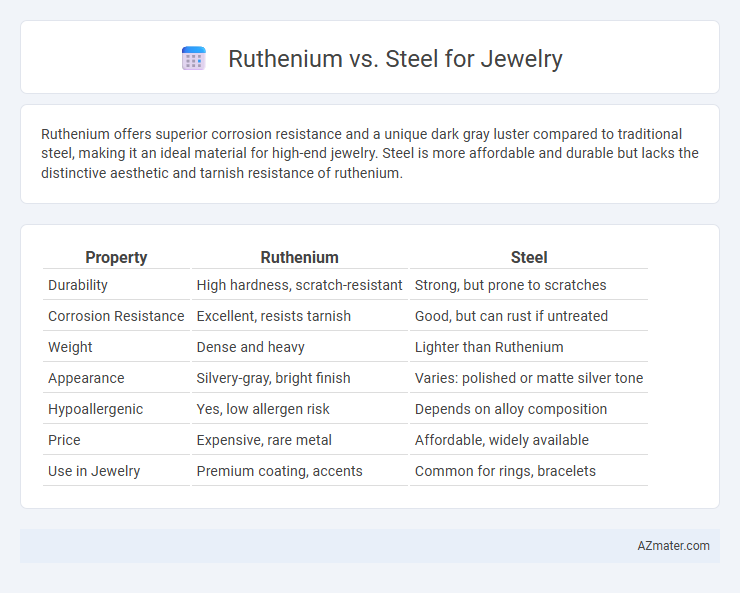Ruthenium offers superior corrosion resistance and a unique dark gray luster compared to traditional steel, making it an ideal material for high-end jewelry. Steel is more affordable and durable but lacks the distinctive aesthetic and tarnish resistance of ruthenium.
Table of Comparison
| Property | Ruthenium | Steel |
|---|---|---|
| Durability | High hardness, scratch-resistant | Strong, but prone to scratches |
| Corrosion Resistance | Excellent, resists tarnish | Good, but can rust if untreated |
| Weight | Dense and heavy | Lighter than Ruthenium |
| Appearance | Silvery-gray, bright finish | Varies: polished or matte silver tone |
| Hypoallergenic | Yes, low allergen risk | Depends on alloy composition |
| Price | Expensive, rare metal | Affordable, widely available |
| Use in Jewelry | Premium coating, accents | Common for rings, bracelets |
Introduction to Ruthenium and Steel in Jewelry
Ruthenium, a rare platinum-group metal, is prized in jewelry for its hardness, corrosion resistance, and striking silver-gray finish that enhances durability and aesthetic appeal. Steel, especially stainless steel, offers affordability, tensile strength, and resistance to tarnish, making it a popular choice for everyday jewelry. While ruthenium provides a premium, scratch-resistant surface often used for plating or accents, steel is valued for its versatility and hypoallergenic properties in mass-market jewelry designs.
Key Physical Properties Comparison
Ruthenium offers exceptional hardness and corrosion resistance compared to steel, making it highly durable for jewelry applications. With a higher melting point around 2334degC, ruthenium retains structural integrity under extreme conditions better than most steel alloys. Steel, while tougher and more flexible, is prone to tarnishing and rust, whereas ruthenium's inert nature ensures long-lasting shine and hypoallergenic properties.
Durability and Wear Resistance
Ruthenium, a rare platinum-group metal, offers exceptional durability and superior scratch resistance compared to traditional steel, making it highly suitable for long-lasting jewelry. Its hardness significantly exceeds that of steel, ensuring better wear resistance and maintaining a polished appearance over time. This makes ruthenium an ideal choice for pieces exposed to daily wear and tear, outperforming steel in maintaining structural integrity and aesthetic appeal.
Appearance and Aesthetic Appeal
Ruthenium offers a strikingly unique appearance with its dark gray to black metallic sheen, providing a modern and sophisticated aesthetic for jewelry. Steel, particularly stainless steel, boasts a bright silver luster and high polish that appeals to those seeking a classic, versatile look. Ruthenium's rarity and uncommon coloration make it ideal for statement pieces, while steel's durability and timeless shine ensure broad wearability and everyday elegance.
Hypoallergenic Qualities and Skin Compatibility
Ruthenium, a rare transition metal, is highly valued in jewelry for its hypoallergenic properties, making it an excellent choice for sensitive skin compared to traditional steel alloys that often contain nickel, a common allergen. Steel, especially stainless steel, is durable and affordable but may cause skin irritation or allergic reactions in some individuals due to nickel content or other impurities. Jewelry made with ruthenium coatings or ruthenium-plated steel offers superior skin compatibility by reducing allergenic exposure while maintaining strength and corrosion resistance.
Maintenance and Care Requirements
Ruthenium, a rare platinum-group metal, offers exceptional resistance to tarnishing and scratches, making it virtually maintenance-free compared to steel. Steel, especially stainless steel, requires regular cleaning and occasional polishing to prevent surface damage and maintain its shine. Ruthenium's durability and corrosion resistance reduce the need for frequent care, providing a longer-lasting, low-maintenance option for jewelry.
Price Differences and Affordability
Ruthenium jewelry often commands higher prices than steel due to its rarity and status as a precious metal in the platinum group, making it less affordable for budget-conscious buyers. Steel, particularly stainless steel, offers a highly cost-effective alternative without sacrificing durability, making it ideal for everyday wear. Price differences stem from ruthenium's limited availability and complex extraction process compared to the mass-produced, widely accessible steel alloys used in jewelry.
Popular Uses in Jewelry Design
Ruthenium, a rare platinum-group metal, is prized in jewelry design for its distinctive dark gray to black finish, often used to enhance the contrast in mixed-metal pieces or as a plating to increase scratch resistance. Steel, particularly stainless steel, is popular for its durability, affordability, and modern aesthetic, making it ideal for everyday wear items like bracelets, rings, and watches. Jewelers favor ruthenium for high-end, statement pieces due to its rarity and corrosion resistance, while steel dominates the market for cost-effective, contemporary jewelry designs.
Environmental and Ethical Considerations
Ruthenium, a rare platinum-group metal, offers a more sustainable alternative to steel in jewelry due to its lower mining impact and higher recyclability, reducing environmental degradation. Steel production often involves significant carbon emissions and energy consumption, while ruthenium's extraction typically requires less intensive industrial processes. Ethical sourcing of ruthenium is increasingly monitored through responsible mining initiatives, whereas steel supply chains can sometimes be linked to labor and environmental concerns.
Choosing the Right Metal for Your Style
Ruthenium offers a hard, tarnish-resistant finish with a unique dark gray to black sheen that enhances modern, edgy jewelry designs, making it ideal for those seeking a bold, contemporary aesthetic. Steel, particularly stainless steel, provides exceptional durability, affordability, and a classic silver tone that suits everyday wear and traditional styles. Selecting between ruthenium and steel depends on desired appearance, wear resistance, and budget, with ruthenium excelling in luxury, high-end pieces while steel remains versatile and practical for daily use.

Infographic: Ruthenium vs Steel for Jewelry
 azmater.com
azmater.com